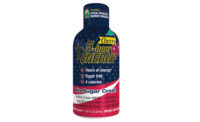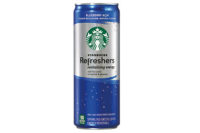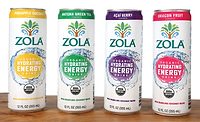In the world of science fiction, fantasy and mythology, shape shifters have the ability to take on the appearance of another person, creature or entity. In the beverage industry, however, energy drinks are making their mark by morphing into other categories while still retaining their primary energy benefit.
The energy concept is being blended with other categories, such as sports drinks and waters, says Richard Haffner, global head of beverages research at Chicago-based Euromonitor International. Purchase, N.Y.-based PepsiCo offers Gatorade G Series Prime pouches to deliver energy before a workout. In the enhanced water category, Northfield, Ill.-based Kraft Foods launched Mio Energy, which brings customization and portability to the energy and enhanced water categories.
In addition to merging categories, energy drinks are incorporating more natural ingredients into their formulations, Haffner adds.
For instance, Camden, N.J.-based The Campbell Soup Co. launched V8 V-Fusion + Energy drinks and V8 Energy Shots last year. The beverages each provide a combined serving of vegetables and fruit as well as a natural energy boost from green tea extract, the company says. Within its first year, V8 Energy Shots showed a 27,168 percent increase in supermarkets, drug stores, gas and convenience stores, and mass market retailers, excluding Walmart, club stores and liquor stores, according to SymphonyIRI Group, a Chicago-based market research firm.
Seattle-based Starbucks Coffee Co. uses green coffee extract to give its Refreshers lineup an energy boost. The newly launched products include handcrafted Starbucks Refreshers, ready-to-drink (RTD) Starbucks Refreshers and instant Starbucks Via Refreshers. RTD Starbucks Refreshers are available in fruit flavors including Raspberry Pomegranate, Strawberry Lemonade and Orange Melon, while the handcrafted Starbucks Refreshers and Starbucks Via Refreshers come in Very Berry Hibiscus and Cool Lime flavors.
The trend toward natural energy drinks started two or three years ago; however, more established players now are joining the segment, says Garima Goel Lal, senior beverage analyst at Mintel, Chicago. By delivering energy and healthful ingredients, these beverages could attract an aging audience, Euromonitor’s Haffner says.
According to Innova Market Insights, Duiven, the Netherlands, natural and no additives/preservatives positionings are top claims of energy drinks — and they will continue to grow. In the United States, Thinq and Golazo energy drinks, among many others, contain all-natural ingredients, Innova states.
Top players
Nevertheless, most of the growth in energy drinks and shots has come from the major players, Mintel’s Goel Lal says. Santa Monica, Calif.-based Red Bull North America Inc.’s flagship Red Bull energy drink remains the No. 1 brand in the energy drink category with nearly a 20 percent increase in sales for the 52 weeks ending May 13 compared to the previous year in measured channels, according to SymphonyIRI data. Earlier this year, the company launched a zero-calorie version of its energy drink called Red Bull Total Zero.
Corona, Calif.-based Monster Energy Co.’s Monster Energy brand also offers a zero-calorie version of its energy drink called Monster Energy Absolutely Zero. Its flagship Monster Energy drink took the No. 2 spot on the top energy drinks list with almost a 21 percent rise, and the company’s Worx Energy shot increased 400 percent, landing
No. 4 on SymphonyIRI’s list of the top energy shots. Las Vegas-based Rockstar Energy’s Rockstar brand came in at No. 3 on the top energy drinks list with nearly a 15 percent increase in the measured channels and time period. PepsiCo's Amp brand landed in the No. 8 spot, while Atlanta-based The Coca-Cola Co.’s Nos brand made the No. 4 spot and its Full Throttle brand just made the Top 10 at No. 10. Overall, the energy drink category increased almost 20 percent compared to last year, SymphonyIRI reports.
In the energy shots segment, Farmington Hills, Mich.-based Living Essentials LLC’s 5 Hour Energy remains the category leader, accounting for the top two positions for the 52 weeks ending May 13 in measured channels. Its original 5 Hour Energy shot increased less than 1 percent compared to the year before, but its Extra Strength energy shot increased 808 percent, according to SymphonyIRI data. The No. 3 spot goes to Andover, N.J.-based NVE Pharmaceuticals’ Stacker 2 6 Hour Power energy shot.
Energy drinks and shots had a very good year in 2011 and there are two reasons why, Euromonitor’s Haffner says. “One is recovering from the recession,” he says. “Because energy drinks are very expensive, they were down in the recession. They started coming back, but we’re also starting to see millennials beginning to substitute energy drinks for coffee. That also is a trend that is helping to pick up the growth in energy drinks.”
Haffner notes that energy shots typically appeal to office workers; however, Mintel’s Goel Lal points out that energy drinks and shots both face the challenge of appealing to older consumers.
“Energy shots are interesting because it would seem that based on the consumption incidence of 5 Hour Energy, which is the leading brand, older people tend to like these shots, but when we look at the actual consumption incidence, it’s actually very low,” she says. “… Apparently energy shots have the similar uphill task [as energy drinks] of increasing penetration among older consumers.”
People between the ages of 18 and 34 consume energy shots most, according to Mintel data, with 20 percent of 18- to 24-year-olds and 18 percent of 25- to 34-year-olds consuming energy shots. Seven percent of consumers between the ages of 55 and 64 consume energy shots, and only 2 percent of consumers older than 65 consume energy shots, Goel Lal says. Plus, teenagers are drinking energy drinks and shots less often, she points out. These demographics are very similar to energy drinks, she adds.
Furthermore, flavors are creating interest in the category, analysts say. Mintel’s Goel Lal notes that lemonade, juice and tea flavors are popular among energy drinks and shots. She points out that Monster’s Rehab line features tea, and one variety also includes lemonade. The brand increased 1,310 percent for the 52 weeks ending May 13 compared to the previous year in supermarkets, drug stores, gas and convenience stores, and mass market retailers, excluding Walmart, club stores and liquor stores, according to SymphonyIRI data.
This summer, Las Vegas-based Xyience Xenergy added Melon Mayhem and Tangerine Twister to its energy drink lineup.
“We consider what is trending, such as retro-inspired flavors that influenced Tangerine Twister, and then add our own distinctive twist, but we never compromise on our promise to use only natural flavors or colors,” said Susan Curry, Xyience’s vice president of operations, in a statement.
The company experienced its strongest sales ever in the first quarter of 2012, it says. According to SymphonyIRI data, the brand increased nearly 34 percent for the 52 weeks ending May 13 compared to the previous year in supermarkets, drug stores, gas and convenience stores, and mass market retailers, excluding Walmart, club stores and liquor stores.
Creative cans
Packaging also has become a point of reference within the energy drink segment. This year, multiple companies launched innovative packaging for their energy drink brands to attract consumers. One such innovation has the ability to cool itself in a number of minutes.
“According to our research, a majority of people like to buy energy drinks cold,” Mintel’s Goel Lal says. “Energy drinks are mostly sold in [convenience] stores, so nationally the cooler space is much less than what it is in the big box retailer space.”
The West Coast Chill Pure Energy can from Joseph Company International enables retailers to save on cooler space by featuring a self-chill button on the bottom of the can, she explains. Using Microcool technology developed, patented and licensed by the company, the can uses carbon dioxide reclaimed from the atmosphere and activated carbon from a renewable vegetable source, the company says. Once a consumer pushes the activation button, it lowers the temperature of the can by 30 degrees Fahrenheit within minutes, it adds.
Other energy drinks use inks to stand out on the shelf and enhance the consumer experience.
Hiball Energy recently launched a line of reformulated sparkling energy waters and organic energy drinks in cold-activated cans. When the cans reach a temperature of 45 degrees Fahrenheit, thermochromic ink on the packaging changes the color of bubble graphics from white to blue, indicating that the beverage is at the ideal drinking temperature, Innova states. GZ Gourmet Food & Beverage Inc.’s Radioactive Energy Drink uses fluorescent ink that glows in the dark under a black light. This helps to differentiate the product and make the brand name more memorable.
Recently, New York-based Pure Growth Partners updated the packaging and brand name for its energy shot. Previously, the Street King energy shot came in a black shrinkwrapped bottle. Now called SK Energy, the main color of the bottle is silver. Recently, the brand’s first TV commercial also made its debut featuring rapper and company investor Curtis “50 Cent” Jackson.
New Whey Nutrition, Oviedo, Fla., also redesigned the packaging for its BetaNox energy shot. The new bottles are shrink-sleeved and feature a sleeker design, a company spokesperson says. Available in Citrus Blast and Berry Lemon Blast flavors, the shots contain B vitamins for enhanced focus and increased metabolism, caffeine to improve alertness, arginine to increase blood flow, citrulline to minimize muscle fatigue and beta alanine to reduce lactic acid, according to the company. It plans to take BetaNox into the on-premise segment by mixing it with other drinks to create a functional cocktail, the spokesperson adds.
Considering the variety of innovative products and well-established brands in the energy drinks and shots marketplace, the future is bright for the category, analysts say.
“The total market is predicted to grow 92 percent between 2011 and 2016, so the outlook for the category remains positive and bright,” Mintel’s Goel Lal says. BI






